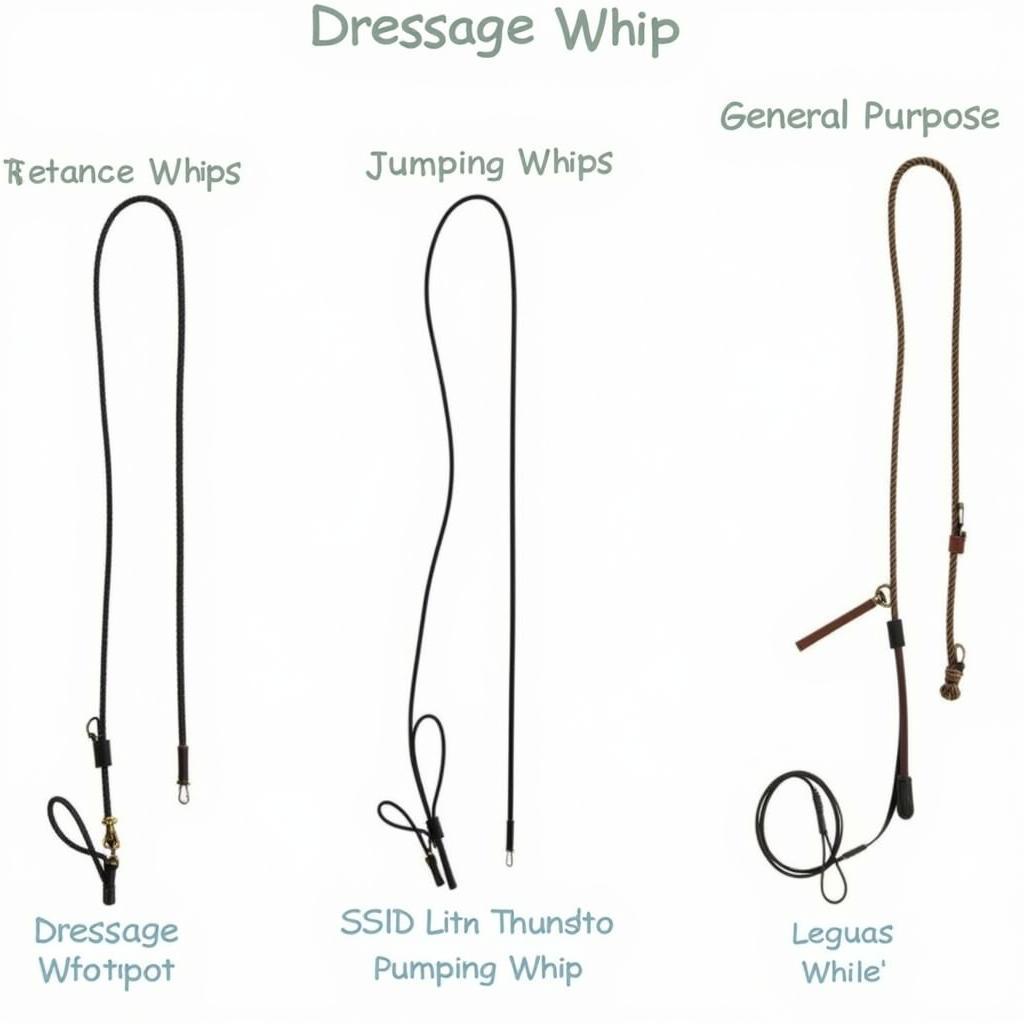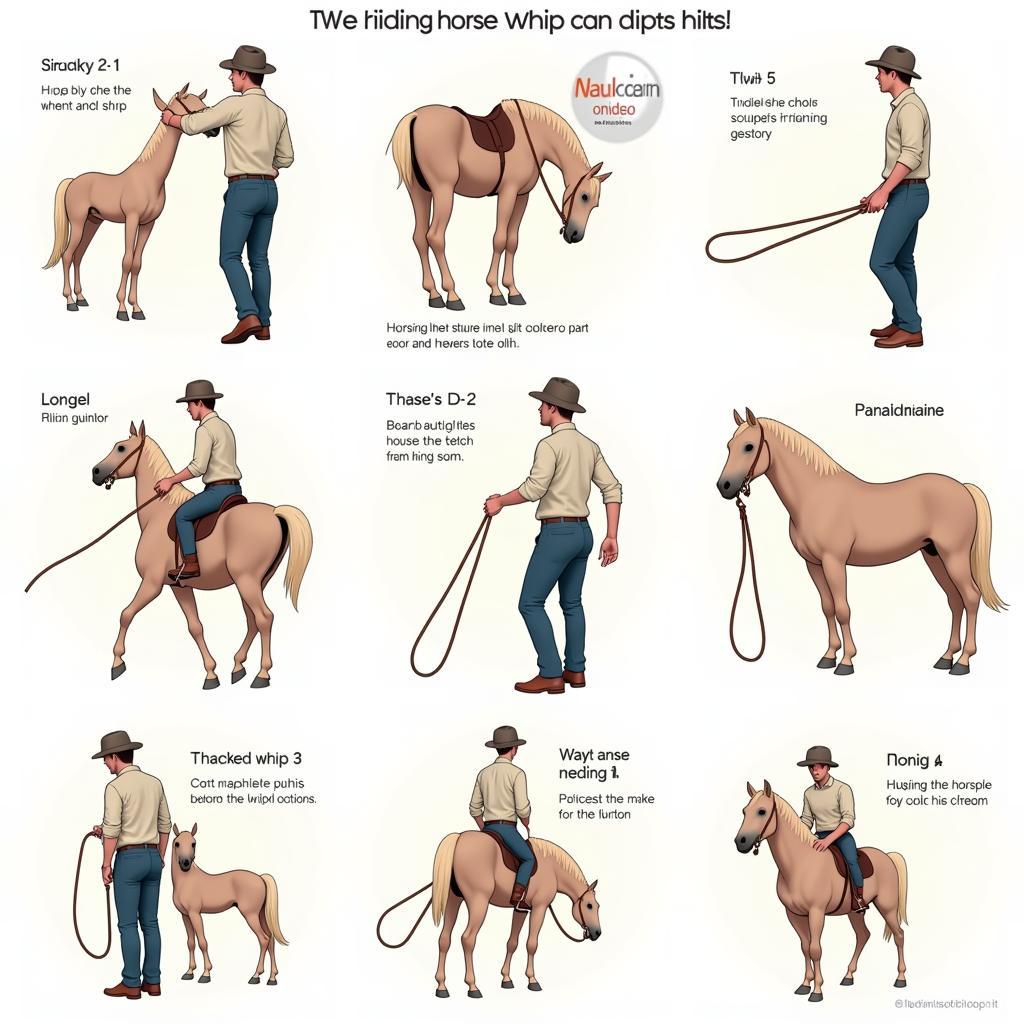The Riding Horse Whip, a seemingly simple tool, plays a significant role in equestrian activities. Understanding its purpose, selecting the right type, and employing correct techniques are crucial for both horse and rider. This guide delves into the nuances of the riding horse whip, providing insights into its effective and humane use.
Decoding the Purpose of the Riding Horse Whip
The riding horse whip isn’t a tool for punishment, but rather an extension of the rider’s leg and aids. It encourages forward movement, refines cues, and reinforces training. Used correctly, it can enhance communication between horse and rider, leading to a more harmonious partnership. Misused, however, it can cause pain, fear, and resentment in the horse.
Beyond its primary function, the riding horse whip also serves as a safety tool in specific situations. It can be used to discourage unwanted behaviors, such as kicking or biting, or to encourage a hesitant horse to move forward in a dangerous situation.
After understanding the foundational purpose of a riding horse whip, exploring the types available will further enhance your knowledge. Check out our riding crops for horses page for a deeper dive into the various options available.
Choosing the Right Riding Horse Whip
The market offers a wide array of riding horse whips, varying in length, material, and design. Choosing the appropriate whip depends on the discipline, the horse’s temperament, and the rider’s preference. Dressage whips are generally longer and thinner, while jumping whips are shorter and feature a wider flapper.
Length is a critical consideration. The whip should be long enough to reach the horse’s flank without excessive arm movement but not so long that it becomes unwieldy. Material also plays a role. Leather whips are traditional and offer a good feel, while synthetic whips are durable and easy to maintain.
 Different Types of Riding Horse Whips
Different Types of Riding Horse Whips
Techniques for Effective Riding Horse Whip Use
The riding horse whip should be held lightly, as an extension of the arm, not a weapon. It should be used with precision and timing, applying a light tap to the horse’s flank only when necessary. Excessive force or erratic whipping can frighten the horse and damage the rider-horse relationship.
Timing is everything. The whip should be used in conjunction with other aids, such as leg pressure or voice commands, to reinforce the desired response. The aim is to guide and encourage, not to punish.
“A well-timed tap with the riding horse whip can be more effective than a harsh yank on the reins,” says renowned equine behaviorist Dr. Emily Carter. “It’s about communicating clearly and consistently with your horse.”
Addressing Common Misconceptions about the Riding Horse Whip
Many misconceptions surround the use of the riding horse whip. Some believe it’s inherently cruel, while others overuse it as a primary means of control. Understanding its true purpose and employing proper techniques can dispel these myths.
The riding horse whip, when used responsibly, is a valuable training aid, not an instrument of punishment. It’s about refining communication, not inflicting pain. By educating ourselves and prioritizing the horse’s well-being, we can ensure its ethical and effective use.
“The riding horse whip is often misunderstood,” explains experienced horse trainer, John Davies. “It’s a tool for communication, not punishment. When used correctly, it can significantly enhance the horse-rider partnership.”
You might also find our article on horse breaking equipment helpful for further understanding of equestrian tools.
 Effective Training Techniques with a Riding Horse Whip
Effective Training Techniques with a Riding Horse Whip
Conclusion: The Riding Horse Whip as a Tool for Partnership
The riding horse whip, when understood and utilized correctly, becomes a valuable tool for enhancing the horse-rider partnership. It allows for clearer communication, refined cues, and ultimately, a more harmonious riding experience. Remember, responsible use is key. By prioritizing the horse’s well-being and focusing on effective techniques, we can ensure the riding horse whip serves as a tool for connection, not conflict. For more information on racing, check out our race horse whip page.
FAQ
- What is the ideal length for a riding horse whip?
- What are the different materials used in making riding horse whips?
- How should I hold a riding horse whip correctly?
- When should I use a riding horse whip during riding?
- Is it cruel to use a riding horse whip on a horse?
- What are some common mistakes to avoid when using a riding horse whip?
- How can I tell if I am using the riding horse whip correctly?
Common Scenarios and Questions
Scenario: My horse is not responding to my leg aids.
Question: Can I use the riding horse whip to encourage forward movement?
Answer: Yes, a gentle tap with the whip can reinforce your leg aid and encourage forward movement. However, make sure you are also using your seat and voice aids effectively.
You can find great gift ideas for horse lovers on our gifts for the horse woman page. And if you are interested in horsehair accessories, visit our hair horse tail page.
Further Exploration
- Explore different types of riding whips and their specific uses.
- Learn more about horse behavior and communication.
- Consult with a certified riding instructor for personalized guidance.
For assistance, contact us at Phone Number: 0772127271, Email: [email protected] or visit our address: QGM2+WX2, Vị Trung, Vị Thuỷ, Hậu Giang, Việt Nam. We have a 24/7 customer support team ready to help.